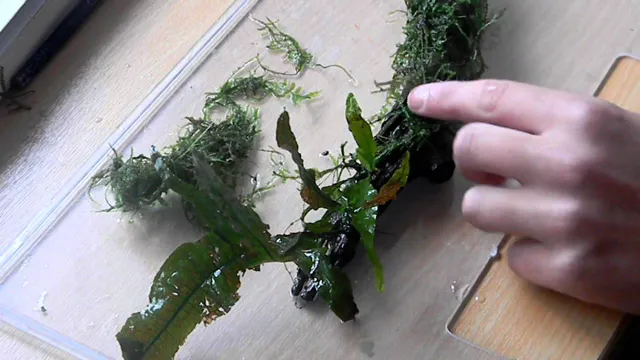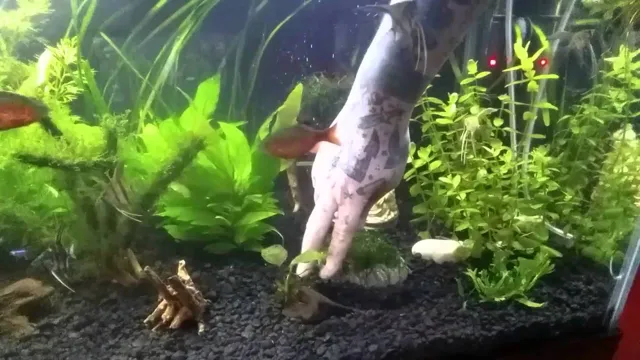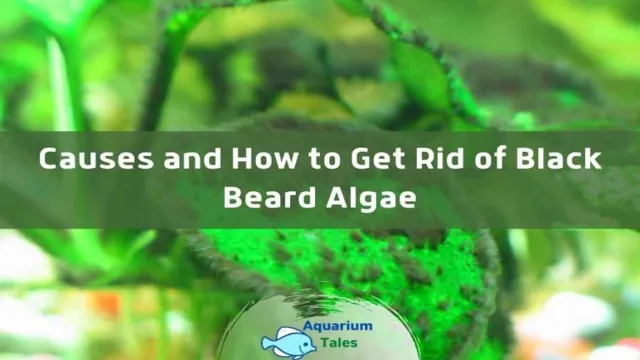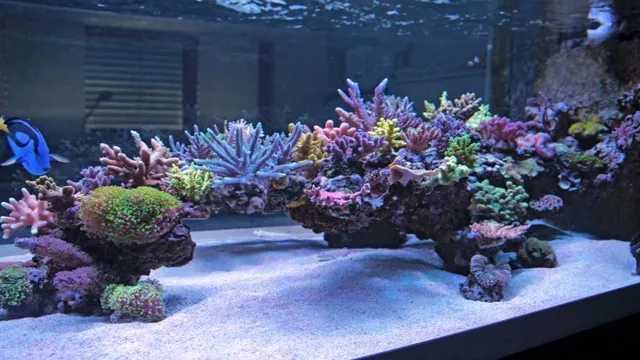How to Get Rid of Algae from Your Aquarium Tank: 9 Proven Methods

Do you have unsightly algae taking over your once pristine aquarium tank, hindering the beauty of your aquatic oasis? Not to worry, removing algae from your aquarium tank is a common issue among fish enthusiasts. Algae is a natural occurrence in aquariums, especially with excess light, imbalanced nutrients, and poor water circulation. However, with a few simple steps, you can combat this pesky growth and restore your tank’s clear water.
In this blog, we’ll be discussing tried-and-true methods for removing algae from your aquarium tank, so you can get back to enjoying the beauty of your fish and aquatic plants. Let’s dive in!
Identifying the Type of Algae
If you’re dealing with algae in your aquarium tank, the first step is to identify the type of algae. There are several different types, each with their own distinct characteristics. For example, green algae is the most common and is typically caused by an excess of nutrients in the water.
Brown algae often appears as a thin film and can be caused by high levels of silicates. Blue-green algae, also known as cyanobacteria, is actually a type of bacteria and can be toxic to both fish and plants. By identifying the type of algae, you can choose the best course of action to effectively get rid of it from your aquarium tank.
So take a closer look at your tank and the algae growing in it to determine the type you’re dealing with.
Green Algae
Green algae identification can be a bit tricky, as there are many different types of green algae out there! However, one important aspect to consider is the shape of the algae. Green algae can take on a variety of forms, from single cells to filaments or even sheet-like structures. If you’re looking at a sample of water under a microscope, you may be able to spot green algae by its bright green color and distinctly plant-like appearance.
Another thing to look out for is whether the green algae is motile or non-motile – some green algae have whip-like appendages called flagella that they use to move through the water, while others are stationary. By considering these factors, you can start to narrow down the identification of green algae and gain a better understanding of the unique characteristics of this fascinating group of organisms.

Brown Algae
Brown algae are a type of marine algae that can be easily identified by their color and structure. They typically have a brownish hue and appear slimy or rubbery in texture. But, besides their appearance, brown algae also have some unique characteristics that make them stand out from other types of algae.
For example, they are multicellular and have a complex structure that includes specialized tissues, such as holdfasts, stipes, and blades. They are commonly found in rocky coastal areas, attached to rocks or other substrates. Brown algae also play a vital role in marine ecosystems, providing food and shelter for various marine species.
Overall, identifying the type of algae is an essential step in studying marine biology and understanding the important role that these organisms play in our oceans. By recognizing brown algae and other types of marine algae, we can better appreciate the beauty and complexity of our oceans and the important role that they play in sustaining life on our planet.
Black Algae
Black Algae
Preventing Algae Growth
Keeping your aquarium tank clean and algae-free is essential for maintaining the health of your aquatic pets. But how do you get rid of algae from aquarium tank? Well, the first step is prevention. Algae thrive in environments with lots of light and excess nutrients.
So, to prevent algae growth, you need to limit the amount of light your tank receives and reduce the amount of nutrients available to the algae. You can do this by performing regular water changes, avoiding overfeeding your fish, and removing any excess plant matter or debris from the tank. Additionally, you can add algae-eating fish and snails to your tank to help keep it clean.
If you do end up with algae growth, there are several natural and chemical treatments available to help get rid of it. Just be sure to follow the instructions carefully, so you don’t harm your fish or the delicate balance of your aquarium ecosystem. By following these preventative measures and taking action if you notice any signs of algae growth, you can keep your aquarium tank looking beautiful and your fish healthy and happy.
Reduce Light Exposure
Reducing light exposure is an effective way of preventing algae growth in water features. Algae thrive on direct sunlight and feed on nutrients in the water. As a result, they multiply and turn your pond or pool green.
To prevent this, you can use shading techniques, such as adding plants that provide shade or installing a canopy. The goal is to block direct sunlight and restrict the amount of light entering your water feature. This will not only reduce the formation of algae but also keep the water cooler, which can be beneficial for aquatic life.
Additionally, you can control the amount of time your water feature is exposed to light by running it during the morning or evening hours when it is not as hot as during the middle of the day. By reducing light exposure, you can keep your water feature clear and healthy, providing a pleasant environment for both aquatic life and humans alike.
Control Nutrient Levels
Preventing algae growth is a common concern for aquarium owners. One effective way to control algae is to manage nutrient levels in the tank. Excess nutrients, such as nitrates and phosphates, can lead to a proliferation of algae.
Regular water changes, careful feeding of fish, and limiting the amount of light can all help control nutrient levels. It’s also important to monitor nutrient levels regularly using testing kits. Another way to tackle excess nutrients is by introducing live plants to the aquarium.
These plants compete with algae for nutrients, helping to control their growth. By taking these measures, aquarium owners can keep their tanks looking clean and healthy while preventing algae from taking over.
Clean the Tank Regularly
Preventing algae growth in your aquarium is key to keeping your fish healthy and happy. One of the best things you can do to prevent algae growth is to clean your tank regularly. Algae thrives in warm, moist environments, and if your tank isn’t cleaned and maintained properly, it can quickly take over.
So, how can you prevent this? First, make sure you remove any uneaten food and waste from the tank on a daily basis. This will help prevent the build-up of bacteria that can contribute to algae growth. Second, replace 10-15% of the water in your tank each week.
This will help keep the water clean and clear, and reduce the availability of nutrients for algae to grow. Finally, clean the tank itself, including the walls and decorations. You can use a soft brush or sponge to gently scrub away any algae that has already formed.
By taking these simple steps to keep your tank clean, you can prevent algae growth and create a healthy environment for your fish to thrive in.
Removing Algae from Your Tank
Algae growth in aquarium tanks can be disruptive to your aquatic ecosystem, causing murky water, decreased oxygen levels and even the death of your fish. There are several methods you can use to keep algae under control and maintain a healthy aquarium. One of the most effective ways is to limit the amount of sunlight your tank receives.
Algae grows rapidly in the presence of light, so reducing your tank’s exposure can be a simple and effective solution. Regular water changes can also reduce the number of nutrients that algae thrives on. You can also consider introducing algae-eating fish or adding chemicals to your tank to control the growth of unwanted algae.
With some patience and careful management, you can successfully keep your aquarium clear of harmful algae and maintain a vibrant, healthy environment for your aquatic family.
Scrubbing with Algae Pads or Brushes
If you’re keeping fish in a tank, then algae is an inevitable problem you’ll likely face at some point. While it might not be particularly harmful to the health of your fish, it can clog filters and make your tank look unsightly. To get rid of it, one option is to use algae pads or brushes.
These are abrasive tools that scrape away algae from the walls of your tank. You can find them at your local pet store, and they’re fairly easy to use. Just be sure to choose one that’s appropriate for your tank size and type of algae you’re dealing with.
While scrubbing regularly can work wonders, be careful not to overdo it, as too much scraping can damage your tank’s finish.
Manual Removal with a Siphon or Net
If you notice a buildup of algae in your fish tank, manual removal with a siphon or net can be an effective solution. It’s important to remove the algae as it can rob the water of essential nutrients and oxygen, harming your fish and other aquatic life. First, use a siphon to remove any loose algae that has settled on the bottom of the tank.
Hold the siphon over the algae and use a gentle suction to lift it up and out of the tank. If there’s a lot of algae on the sides of the tank, use a net to remove it. Simply run the net along the surface of the water, catching the algae in the net and removing it from the tank.
It’s important to note that removing too much algae at once can disrupt the balance in your tank, so be careful not to go overboard. With regular maintenance and manual removal, you can keep your tank healthy and beautiful for your aquatic pets to thrive in.
Chemical Solutions
If you’re an aquarium owner, you may have encountered the frustrating problem of algae taking over your tank. Not only is it unsightly, but it can also have negative effects on the health of your fish and plants. Luckily, there are chemical solutions available to help get rid of algae in your aquarium.
One effective option is to use an algae control product that contains copper, which can kill off the algae. However, it’s important to be cautious with copper, as too much can be harmful to your aquatic life. Another option is to use an algaecide, which can be a more targeted solution for specific types of algae.
It’s important to follow product instructions carefully and monitor your water quality regularly to ensure a healthy environment for your aquarium inhabitants. By taking proactive measures and utilizing chemical solutions when necessary, you can keep your aquarium clean and beautiful.
Algaecides
Algaecides are crucial chemical solutions for maintaining the cleanliness and clarity of swimming pools, aquariums, and other water bodies. Algae can grow rapidly and cause numerous problems such as slippery surfaces, foul odors, and clogged filters. Algaecides work by destroying or inhibiting the growth of algae, preventing them from forming colonies.
They are available in various types, including copper-based, quaternary ammonium-based, and polymeric. Copper-based algaecides are the most popular due to their effectiveness in eradicating stubborn algae strains. However, excessive use can lead to discoloration of pool or aquarium surfaces.
Quaternary ammonium-based algaecides are ideal for preventing the growth of algae but may require higher doses to kill existing ones. Polymeric algaecides are eco-friendly and long-lasting, but they may not be effective against all types of algae. It is crucial to follow the manufacturer’s instructions and dosage recommendations when using algaecides to avoid damaging the water ecosystem and equipment.
So, when choosing an algaecide, consider the type of algae present and the specific needs of the water body.
Hydrogen Peroxide Treatment
Hydrogen peroxide is a clear, odorless liquid that has long been used as an antiseptic and disinfectant. In recent years, it has gained popularity as a treatment for a variety of ailments due to its many benefits. Hydrogen peroxide works by breaking down into water and oxygen, which kills harmful bacteria and viruses.
It can be used to clean wounds, whiten teeth, and even disinfect produce. However, it is important to use hydrogen peroxide safely and properly, as it can be harmful in large quantities or if used improperly. When diluted correctly, though, hydrogen peroxide can be a powerful and effective alternative to harsher chemical treatments, making it a great choice for those looking for natural solutions to their health and hygiene needs.
UV Sterilizer
UV sterilizers are a popular and effective way to combat harmful bacteria and germs in water. However, some people may be wary of using them due to concerns about chemicals. Luckily, there are chemical-free solutions available for those who want to avoid adding additional chemicals to their water.
One option is to use a pre-filter before the UV sterilizer, which can remove any large particles or sediment that may be present in the water. Another option is to use a UV sterilizer that utilizes ozone instead of chlorine or other chemicals. Ozone is a naturally occurring gas that can effectively kill bacteria and viruses without leaving any harmful byproducts.
By choosing a chemical-free solution for your UV sterilizer, you can rest assured that your water is safe to drink without any unwanted chemicals.
Conclusion
In conclusion, getting rid of algae from your aquarium tank can be quite a challenge, but with a few simple steps, you can have a crystal-clear tank in no time. Remember to maintain proper lighting, limit nutrients like excess food and waste, keep your filter clean, and don’t forget to add some aquatic snails or fish to help clean up any remaining algae. If all else fails, you can always invite your mother-in-law over for a visit – her criticism will surely scare off any remaining algae!”
FAQs
What causes algae to grow in an aquarium tank?
Algae growth is mainly caused by excess nutrients, like phosphates and nitrates, in the water in combination with light exposure.
Should I completely clean out my aquarium tank to get rid of algae?
No, it is not recommended to completely clean out your aquarium tank as it can harm the good bacteria and disrupt the nitrogen cycle. Instead, focus on reducing excess nutrients and light exposure, and spot cleaning the affected areas.
Can adding live plants to my aquarium help get rid of algae?
Yes, adding live plants can help control excess nutrients and light exposure, thereby reducing algae growth. However, make sure to properly maintain and prune the plants to prevent them from becoming a source of excess nutrients.
Are there any natural remedies to get rid of algae in my aquarium tank?
Yes, some natural remedies include adding a small amount of hydrogen peroxide or vinegar to the tank, increasing water flow, and introducing algae-eating organisms like snails or shrimp.
Why does my aquarium tank keep getting algae even though I clean it regularly?
Cleaning alone is not enough to control algae growth. You need to identify and address the root cause of the excess nutrients and light exposure, as well as maintain proper filtration and water flow.
Can overfeeding my fish contribute to algae growth in my aquarium tank?
Yes, excess food not consumed by the fish can break down and release excess nutrients into the water, leading to algae growth. So, make sure to feed your fish only the amount they can finish within 2-3 minutes.
How often should I change the water in my aquarium tank to prevent algae growth?
It depends on various factors like the size of your tank, the number of fish, the type of filter used, and the plants involved. However, as a general rule, aim for changing 10-20% of the water every 2-4 weeks to maintain optimal water quality and prevent algae growth.






